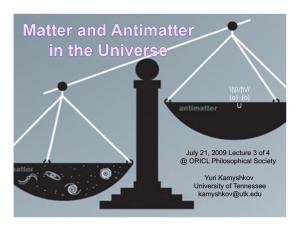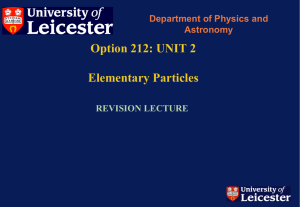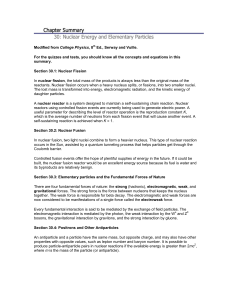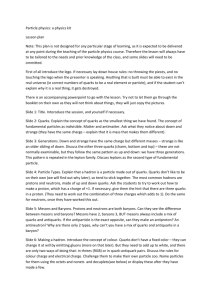SOLUTIONS - PHY583 - Test 3 - AS2315M
advertisement
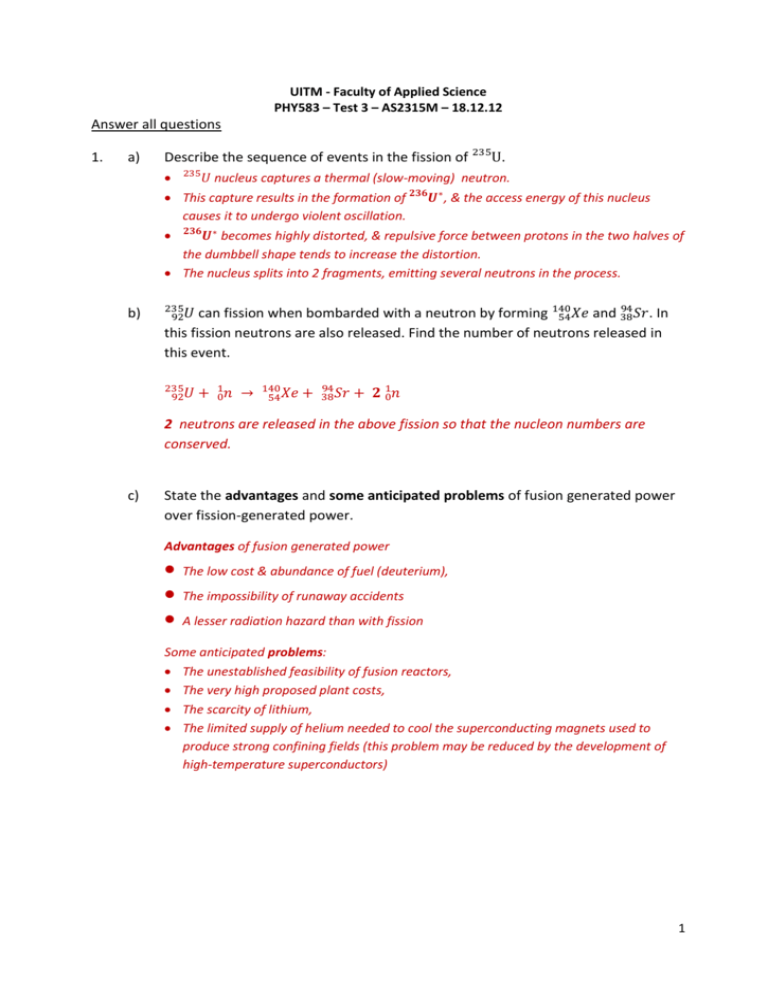
UITM - Faculty of Applied Science PHY583 – Test 3 – AS2315M – 18.12.12 Answer all questions 1. a) Describe the sequence of events in the fission of 235U. 235 𝑈 nucleus captures a thermal (slow-moving) neutron. This capture results in the formation of 𝟐𝟑𝟔𝑼∗, & the access energy of this nucleus causes it to undergo violent oscillation. 𝟐𝟑𝟔 ∗ 𝑼 becomes highly distorted, & repulsive force between protons in the two halves of the dumbbell shape tends to increase the distortion. The nucleus splits into 2 fragments, emitting several neutrons in the process. b) 235 92𝑈 94 can fission when bombarded with a neutron by forming 140 54𝑋𝑒 and 38𝑆𝑟 . In this fission neutrons are also released. Find the number of neutrons released in this event. 235 92𝑈 + 10𝑛 → 140 54𝑋𝑒 + 94 38𝑆𝑟 + 𝟐 10𝑛 2 neutrons are released in the above fission so that the nucleon numbers are conserved. c) State the advantages and some anticipated problems of fusion generated power over fission-generated power. Advantages of fusion generated power The low cost & abundance of fuel (deuterium), The impossibility of runaway accidents A lesser radiation hazard than with fission Some anticipated problems: The unestablished feasibility of fusion reactors, The very high proposed plant costs, The scarcity of lithium, The limited supply of helium needed to cool the superconducting magnets used to produce strong confining fields (this problem may be reduced by the development of high-temperature superconductors) 1 2. a) Describe the two categories of radiation damage in biological systems. Somatic damage is the damage associated with any body cell except the reproductive cells. At high dose rate this can lead to cancer or seriously alter the characteristics of specific organisms. Genetic damage affects only reproductive cells. Damage to the genes in reproductive cells can lead to defective offspring. b) Briefly explain the following radiation detectors, i) the cloud chamber and A cloud chamber: Contains a vapour that has been supercooled to just below its usual condensation point. An energetic particle passing through the chamber ionizes the vapour along its path. These ions serve as centres for condensation of the supercooled vapour. The tract can be seen with the naked eye & can be photographed. A magnetic field can be applied to determine the charges of the particles as well as their momentum & energy. ii) Geiger counter. The most common form of ion chamber. It can be considered as the prototype of all counters that use the ionization of the medium as the basic detection process. makes use of the electron-pairs generated by the passage of radiation through a gas to produce an electrical signal. 3. a) Describe the four fundamental forces of nature and the field particle that mediates each. Strong force A force that holds nucleus together Short-ranged 1 fm The strongest of the four forces Field particles are gluons Electromagnetic force Force between charges that holds atoms and molecules together Infinite range Obeys inverse-square law Field particles are photons 2 Weak force Involved in many decays of nuclear particles which require a change of a quark from one flavor to the onother accounts for the decay of nuclei & the decay of heavier quarks & leptons. Range 1018 m Its strength is 106 times that of the strong force. Scientists now believe that the weak & electromagnetic forces are two manifestations of a unified force called the electroweak force. Field particles: W, Zo particles Gravitational force Attractive force between two masses Infinite range The weakest of the four forces 1043 times that of a strong force. Obeys inverse-square law Although this force holds the planets, stars & galaxies together, its effect on elementary particle is negligible. Fields particles are gravitons but this particle is not yet discovered. b) List all the fundamental particles known today. Leptons: electron, electron-neutrino, muon, muon-neutrino, tau, tau-neutrino Force field carriers: gluons, photons, W+, W, and Z-boson Quarks: up, down,strange, charmed, bottom, top Newly discovered: Higgs boson c) Describe thefollowing classification of particles: i) Hadrons Particles that interact through the strong force. Two classes of hadrons: mesons (spin 0 or 1) & baryons (spin odd half-integer values 1 3 5 , , ,..) 2 2 2 Composite particles composed of more elemental units called quarks. ii) Mesons A type of hadron made up of a quark and an antiquark. All have spin 0 or 1, Their masses between that of the electron & proton. All mesons are known to decay finally into electrons, positrons, neutrinos & photons. Eg. Pion and Kaon iii) Baryons Another type of hadrons, made up of 3 quarks. 1 3 5 Their spins are always odd half-integer values (2 , 2 , 2 , 𝑒𝑡𝑐). 3 Have masses equal to greater than the proton E.g. Protons & neutrons With the exception of the proton, all baryons decay in such a way that the end products include a proton. 4. a) State the fundamental interactions responsible for the following decays and provide the reasoning for your answer. i) Delta plus (+) decays into a pion (+) and a neutron (n) with half-life of about 1024 s. ∆ + → + + n Strong force because the half-life is < 1020 s. ii) The neutral kaon (K0) decays into two pions (+ and ) with half-life of about 1010 s. 𝐾 0 → + + − Weak force because the half-life is 1010 s. b) Explain the three conservation laws applied only in particle physics. Conservation of baryon number Whenever a nuclear reaction or decay occurs, the sum of the baryon numbers before the process must equal the sum of baryon numbers after the process. An equivalent statement: the net number of baryons remains constant in any process. To apply conservation of baryon number, assign baryon number B = +1 for all baryons, B = 1 for all antibaryons, & B = 0 for all other particles. Conservation of lepton number Three conservation laws involving lepton numbers, one for each variety of lepton: The law of conservation of electron-lepton numbers (lepton flavour conservation) states that the sum of the electron-lepton numbers before a reaction or decay must equal the sum of the electron-lepton numbers after the reaction or decay. [similar statement for muon-lepton & tau-lepton] The electron & the electron neutrino are assigned a positive lepton number, Le = +1. The antileptons e+ & 𝜈̅ e are assigned a negative lepton number, Le = 1. All others (the muon & tau families) have Le = 0. Conservation of strangeness The law of conservation of strangeness states that whenever a nuclear reaction or decay occurs, the sum of the strangeness before the process must equal the sum of the strangeness numbers after the process. 4 The slow decay of strange particles can be explained by assuming that the strong & electromagnetic interactions obey the law of conservation of strangeness but the weak interaction does not. c) Briefly explain what is meant by Quantum Chromodynamics. Quantum Chromodynamics (QCD) is the general theory of how quarks interact with each other. In QCD the color charge carried by each quark is responsible for the strong force between the quarks. Basic color charge interaction: like colors repel, opposite colors attract d) State 3 areas of research and development carried out by Nuclear Malaysia. Medical Technology Waste, Water & Environment Agro Technology Industrial Technology Radiation Technology Nuclear Reactor Technology Any 3 5

